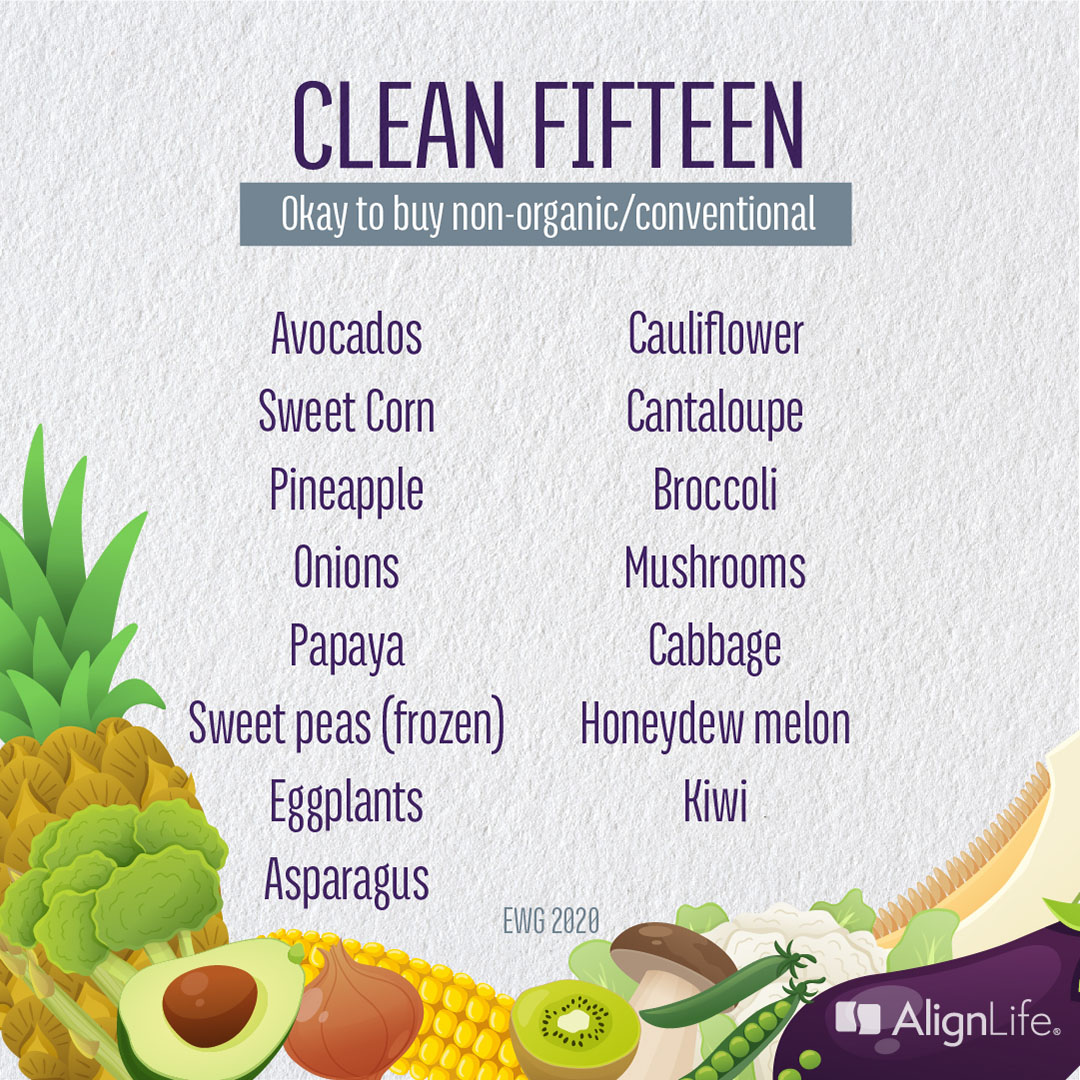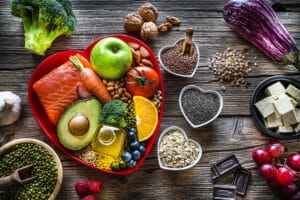I consider myself someone that is pretty mindful of what I’m feeding myself and my family. Our family aims to achieve a fairly well-rounded diet that includes fruits and vegetables. I have been known to gloat over the beauty of my green smoothies. And I always encourage my children to snack on fruits or veggies. However, when I started researching how to shop for the best fruits and vegetables and came across the Dirty Dozen and Clean 15, it became clear to me that I needed to level up my shopping game. I also realized it was time to splurge on organic for some of our favorites.
Keep reading to see what these produce shopping guides can teach us.
The Clean Fifteen & Dirty Dozen: An Easy Guide to “Clean Eating”
I’d argue that most people care about what they are putting into their bodies and assume that they are making good choices if they manage to sneak in some daily fruits and vegetables, especially with children. But how do you know you’re making the best choices? Enter the Dirty Dozen and Clean 15.
Perhaps, you’ve heard these lists mentioned before in passing, but you may not know exactly what they are or why they’re important. In this article, we’ll dive into what the Dirty Dozen and Clean Fifteen are, how they came to be, and how you can use them to make even better and well-informed choices about what you are shopping for and eating.
Who created the Dirty Dozen and Clean Fifteen?
The Clean Fifteen and Dirty Dozen lists are released by the Environmental Working Group (EWG). EWG is a non-profit, non-partisan organization dedicated to protecting human health and the environment. They research what’s in our tap water, the safety of our cosmetics, genetically modified organisms (GMO/GE), and the amounts of pesticides in and on our food, among other things.
The EWG’s Shopper’s Guide to Pesticides in Produce™ (aka Dirty Dozen and Clean 15) is updated each year and ranks pesticide contamination on 47 popular fruits and vegetables. The guide is based on results of more than 35,200 samples tested by the U.S. Department of Agriculture and the Food and Drug Administration.
What is listed on the Clean Fifteen and Dirty Dozen?
The top 15 foods with the least pesticides are called the Clean 15, while the 12 foods with the most pesticides are called the Dirty Dozen. These lists are fantastic to take with you on your weekly shopping trips to know when to buy organic and when it’s ok to buy conventional.
In an ideal world, you’d only buy food that is not sprayed by pesticides at all. That’s why organically produced food or homegrown food are becoming more popular. But we know the cost associated with buying 100% organic can be high, and that it isn’t always feasible or available to grow your own food. Taking these lists with you as your go-to shopping guides will help you make smart decisions as you’re cruising the food aisles at the market. Let’s take a closer look and see how the Dirty Dozen and Clean Fifteen can help you choose the best produce.
The Dirty Dozen (2020)
Topping the Dirty Dozen list for at least the last three years is strawberries. In fact, more than 90 percent of strawberries, apples, cherries, spinach, nectarines, and kale sampled tested positive for residues of two or more pesticides, according to the EWG study.
Also included in the Dirty Dozen are grapes, peaches, pears, tomatoes, celery, and potatoes. Not listed in the top 12, but showing alarming levels of pesticides, are hot peppers and sweet bell peppers. Raisins, considered a “healthy snack” by many health-conscious moms, also tested high for pesticide residue. They didn’t make the official list because they are a processed food. If raisins had, they would rank above strawberries!
The Clean Fifteen (2020)
On the flip side, the EWG also releases a list of the cleanest freshest produce every year. Avocados currently top that list! Less than 2 percent of avocados sampled showed any detectable pesticides. That means if you’re looking for places to save some dollars, it’s totally cool to buy conventional avocados. Additionally, all other products on the Clean Fifteen — except for cabbage — tested positive for four or fewer pesticides, and almost 70 percent of the Clean 15 fruit and vegetable samples had no pesticide residues!
In addition to asparagus, you’ll also get the go-light to buy these “clean” fruits and veggies from the non-organic or conventional section. They include sweet corn, pineapple, onions, papaya, frozen sweet peas, eggplant, asparagus, cauliflower, cantaloupe, broccoli, mushrooms, cabbage, honeydew melon, and kiwi.
How Much Pesticide Residue is on Produce?
So how important is it to avoid the Dirty Dozen and shop organic? Should you be avoiding pesticides at all costs and worrying about how clean your food is? After all, if it’s on the supermarket shelf, isn’t it safe to eat? Not necessarily.
Many crops contain potentially harmful pesticides, even after washing, peeling, or scrubbing, which the USDA does before testing each item. According to EQG’s analysis of the latest test data from the federal Department of Agriculture, nearly 70 percent of the fresh produce sold in the U.S. contains residues of potentially harmful chemical pesticides.

Pesticides are chemical or biological agents that are used to protect crops from insects, weeds, and infections. Acutely toxic organophosphate (OP) pesticides are widely used on crops in the United States. Because contamination varies by crop, it is important to understand which items are most or least contaminated as you build your shopping lists.
High Levels of Pesticides May Affect Your Health
Studies are varied on how these pesticides can impact your health, but research has linked high levels of pesticides to an increased risk of ADHD in children. They have also linked an organic-only diet to a reduced risk for cancer. You could spend hours reading a variety of research on this topic with varied results on the true impact pesticides have on humans.
One thing that does seem clear is that we need to learn more. According to the EWG, Americans are likely polluted far more with pesticides than current studies report. One reason for this is reporting. Agribusiness and pesticide companies are not required to determine whether their chemicals are present in people. This includes chemical compounds that are widely found in the food supply.
How to Make “Cleaner” Food Choices
Whether you choose organic or conventionally grown, fruits and vegetables are critical components of a healthy diet. There is also an overwhelming amount of scientific evidence that points to the many health benefits of adding more fruits and vegetables to your diet. Yet many Americans still don’t get enough. Even though we know our bodies love and need them, 87 percent of Americans don’t eat the daily recommended amount of vegetables and 76 percent don’t eat enough fruit.

It’s also important to note that the Dirty Dozen and Clean Fifteen lists should be used as a guide for shopping. Just because something is on the Dirty Dozen list doesn’t mean you should avoid it all together. In fact, the EWG states that “Everyone should eat plenty of fresh fruits and vegetables, whether organic or conventional. The health benefits of such a diet outweigh the risks of pesticide exposure.”
More Ways to Integrate the Dirty Dozen & Clean Fifteen
Integrating the Dirty Dozen and Clean Fifteen into your life can begin with tiny steps. Simply being more mindful of what you consume is a great start. Here are a few more ideas on how to use this list for your meal planning:
- Find an organic option if available.
- Clean your fruits and vegetables with more than a quick rinse.
- Take a screenshot of the Dirty Dozen and Clean Fifteen foods. Keep these on your phone to revisit while you’re at the market.
- Buy your fruits and veggies at a farmer’s market, direct from the source when possible.
- Start a summer garden.
Better Your Health One Fruit or Vegetable at a Time

Making these small, informed choices can lead to great benefits. But if you need more guidance on what to shop for and how to improve your nutrition, simply ask your local AlignLife Chiropractor to help point you in the right direction.





